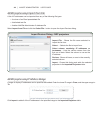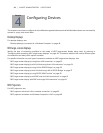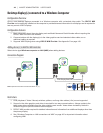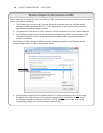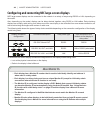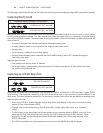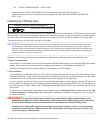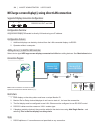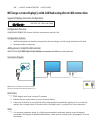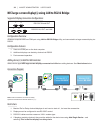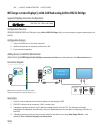
50 | NAVISET ADMINISTRATOR 2 USER’S GUIDE
The following sections describe each of the 3 basic connection types for connecting multiple NEC large-screen displays.
Connecting Directly to LAN
Supported display connection congurations
RS-232C
IN
RS-232C
OUT
LAN
RS-232C IN, OUT, and LAN
LAN1 LAN2
RS-232C
RS-232C IN, LAN 1 and LAN2
Models that have an RJ45 LAN connection can be individually connected directly to a LAN via a hub or switch instead
of daisy-chaining displays together. This may require more wiring since each display is individually connected directly
to a central LAN hub or switch. The advantages of using this method is that communications to other displays will still
function even if:
• A display is removed from the video wall without bridging the daisy-chain.
• A display loses AC power or is turned off via the display’s main power switch.
• A display fails.
• There is a fault in cabling to an individual display.
• A display enters standby power mode and the LAN POWER setting is set to OFF (models that support
LAN daisy-chain only).
Important points to note:
• Each display must have a unique IP address.
• Since each display is addressed by the combination of IP address and Monitor ID, each display can have
the same or unique Monitor IDs.
Connecting via an RS232 Daisy-chain
Supported display connection congurations
RS-232C
IN
RS-232C
OUT
RS-232C IN and OUT
RS-232C
IN
RS-232C
OUT
LAN
RS-232C IN, OUT, and LAN
Models that have two RS232 connections (not including any RS232 connections on OPS devices), support RS232
daisy-chaining. The connection labeled IN is the input to the display from a host computer or previous display in the
daisy-chain. The other connection labeled OUT is the output to connect to the IN on the next display in the daisy chain.
Important points to note:
• When using RS232 to connect displays using a daisy-chain, each display on the chain must have a unique
Monitor ID (set via the display’s OSD).
• Displays must be connected using an RS232 serial NULL modem cable (also known as a “crossover”
cable).
• The rst display in the daisy-chain can be connected to a host computer either via RS232, or by LAN if the
model has an RJ45 LAN connection (not including any RJ45 LAN connections on OPS devices). When
connected via LAN, the rst display can forward commands received over LAN to other displays in the
RS232 daisy-chain.
• The RS232 connection from a host computer must connect to the RS232 IN on the rst display.





